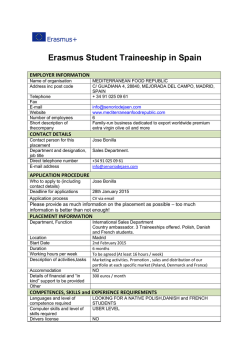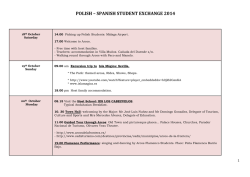
Introduction
Introduction Introduction Our guidebook on urban ecosystem services opened a new era in the history of our series entitled Sustainable Development Applications. It was our first thematic publication dedicated entirely to the extremely relevant issues of nature in the city. Given the importance of this topic we decided to continue with it in the fourth and now fifth guidebook which you are now holding in your hands (or reading on your computer screen). This time our focus is on water in the city. Water and greenery are very strictly interrelated: urban greenery may not be efficiently managed independently of water just as it is impossible to effectively solve the qualitative and quantitative problems of water management without taking green infrastructure into account. This interrelationship is well illustrated by examples of ecological engineering or ecohydrology: two concepts that we often refer to in our publications as these effectively combine ecological and engineering knowledge to increase the effectiveness and efficiency of natural system management. While the two previous publications dealt with urban greenery, the current guidebook is dedicated to water in the city. The opening chapter of this publication is entitled “Water as the backbone of quality of life in the cities of the future” and presents the challenges of urban water management in the context of the global challenges of sustainable development and the actions undertaken in this field by international organizations. Subsequent chapters show the practical issues associated with urban water management at the strategic, planning, health, financial and technical levels; all of these topics are eventually summarized in the chapter on integrated urban management. As before, the last chapter of this guidebook presents a collection of good practices, in this case related to urban stormwater management. The figure below illustrates the interrelationships between the chapters of the last three guidebooks of the series entitled Sustainable Development Applications (3–5), showing how the problems discussed in this guidebook are closely related to those in our 6 | Sustainable Development Applications no 5, 2014 previous publications. Aiming to show the practical relationships between the discussed issues, this time we decided to additionally illustrate most of these with concise case studies at the end of each chapter. In many cases urban water-related issues are placed in the broader context of managing the urban natural system or even more broadly, the socio-ecological system of the city. Over the last two years, the Sendzimir Foundation has given a great deal of consideration to water in the city. This included local projects carried out as part of the Foundation’s Summer Academy “Challenges of sustainable development” series (in the years 2013 and 2014) and Autumn Academy “Challenges of Sustainable Water Management” in 2013. These were organized within the framework of a project entitled “Challenges of Sustainable Water Management. Ecosystem services in an era of climate change” which received funding from the National Fund for Environmental Protection and Water Management and the patronage of the Minister of the Environment. Participants tried to solve the problems of water management in the cities of Torun, Poznan and Krakow in cooperation with municipal authorities and other stakeholders. The reports prepared by the participants of these Academies provide many practical tips and are available for downloading from the Sendzimir Foundation’s webpage. The last of these reports concerning sustainable stormwater management in Krakow (where the example of a community housing estate at Magnolia St. was used) was especially revealing and convinced us of the need to carry out large demonstrative projects of this type in Poland. Projects where such solutions were implemented on a large scale in housing estates in other countries include Augustenborg (MalmÖ, Sweden) and Kronsberg (Hannover, Germany). These undertakings are described in the good practices section at the end of this guidebook to serve as inspiration. Similar implementations in Poland could easily be classified as priority projects of urban revitalization where European Union funds could be used. Urban investments could also benefit from other solutions such as green public procurement. Demonstrative projects of this type could become the seedlings of broader sustainable urban stormwater management programmes, such as in Augustenborg and Kronsberg. On a smaller scale, the Sendzimir Foundation has contributed to the promotion of the practical implementation of this type of solution by building small showcase rain gardens in Lodz and offering brochures with information on rain gardens adjusted to the Polish climatic conditions and indigenous plant species. Rain gardens are particularly strongly popularized in Australian cities, e.g. Melbourne which we featured in one of the good practices of the previous guidebook (SDA4). Last but not least, residents themselves have pointed to the interrelationships between urban water and greenery through an internet application at <www.licznazielen.pl> developed for the major Polish cities of Krakow, Lodz, Poznan and Warsaw as part of the “Licz na zieleń” project (Polish for “Count on greenery”). In the implementation of this project, the Sendzimir Foundation has benefited Urban ecosystem services (SDA3) from the best experience in Participatory Geographic Information Systems and so-called geosurveys, solutions presented in the previous guidebook published in this series. These are now being applied by the Sendzimir Foundation in collaboration with the authorities of the abovementioned cities to support nature management in Polish cities. A review of the maps with survey results shows that when asked to indicate places where they like to spend time among greenery (or other valuable green spaces), residents of the abovementioned cities commonly point to those related with water. Whether planning the further development of Polish cities, applying for financing for revitalization projects from European Union funds or implementing the guidelines of the Polish National Urban Policy, nature-related issues should receive more attention. This was our consideration when preparing this and previous guidebooks published in this series. Now we may only wish that the readers find the contents inspiring and useful to improve the quality of life in cities. Tomasz Bergier, Jakub Kronenberg, Iwona Wagner WATER AND THE URBAN NATURE SYSTEM Water as the backbone of quality of life in the cities of the future (SDA5) How to assess the value of nature? Valuation of street trees in the Lodz city centre (SDA3) Urban water ecosystem services (SDA3) Blue aspects of green infrastructure (SDA4) URBAN WATER MANAGEMENT Barriers to preserving urban trees and ways of overcoming them (SDA3) Water in the urban space and integrated urban management (SDA5) Tools for strategic planning and management of urban water (SDA5) SPATIAL PLANNING, URBAN PLANNING PUBLIC PARTICIPATION The role of urban planning and architecture in water management (SDA5) Public participation in decision making on urban nature (SDA3) How to safely retain rainwater in the city: technical tools (SDA5) The financial mechanisms of urban stormwater management (SDA5) Water in the urban space and the health of residents (SDA5) Geographic information systems in participatory management of nature in the city (SDA4) Structural soils and other ways of facilitating tree growth in the difficult habitat conditions of cities (SDA4) Unconventional forms of interdisciplinary collaboration in shaping urban greenery: the example of London (SDA4) The planning and principles of tree protection in the investment process (SDA4) Innovative ways of supporting the establishment of green infrastructure in cities: collaboration of local authorities with investors and property owners (SDA4) The local spatial management plan as a tool for nature management in the city (SDA4) Replacement tree planting in cities: key problems related to administrative decisions (SDA4) Balancing inner city development and biodiversity protection on urban wastelands – the Central Railway Area of Munich (SDA4) TECHNICAL INSTRUMENTS FINANCING Tree protection at the construction site (SDA4) The protection of urban trees and the perceived safety hazard (SDA4) Sustainable Development Applications no 5, 2014 | 7
© Copyright 2026

